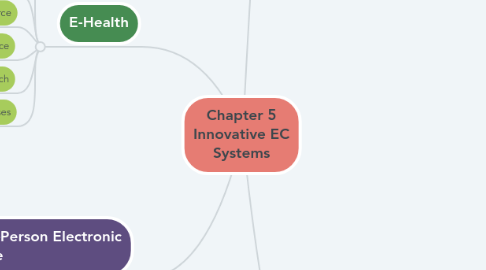
1. E-Health
1.1. Definition
1.1.1. The transfer of health resources and health care by electronic means.
1.2. Electronic Medical Record Systems (EMR)
1.3. Social Media and Commerce
1.4. Medical Devices and Patients Surveillance
1.5. Medical Research
1.6. Administrative Purposes
2. Person-to-Person Electronic Commerce
2.1. Person-to-Person (P2P) EC
2.1.1. P2P Auctions
2.1.2. Selling and Buying in P2P
2.1.2.1. Person-to-Person Money Lending
2.1.3. Classified Ads
2.1.4. Personal Services
2.1.5. File-Sharing Utilities: Napster and Others
2.1.6. P2P Activities in Social Networks and Trading Virtual Properties
3. E-Government
3.1. Definition and Scope
3.1.1. Stream of data between the Government and Citizens, Government and Businesses and Government and Government.
3.2. Government to Citizen
3.2.1. Electronic Voting
3.2.1.1. Voting that uses electronic means to either aid or take care of casting and counting votes.
3.2.2. Electronic Benefits Transfer
3.3. Government to Busines
3.3.1. Government E-Procurement
3.3.2. Group Purchasing
3.3.3. Forward E-Auctions
3.4. Government to Government
3.5. Government-to-Employees and Internal Efficiency and Effectiveness
3.5.1. Government-to-Employees (G2E)
3.5.2. Internal Efficiency and Effectiveness (IEE)
3.6. Implementing E-Government
3.7. The Transformation to E-Government
3.8. E-Government 2.0 and Social Networking
3.8.1. Government 2.0
3.8.2. The Potential of E-Government 2.0
3.9. M-Government
3.9.1. Mobile government (m-government)
3.9.2. The Benefits of M-Government
3.9.3. Some Implementation Issues
3.9.4. Applications
4. E-Learning, E-Training, and E-Books
4.1. E-Learning
4.1.1. The Drivers of E-Learning
4.1.1.1. Availability of educational materials and content online
4.1.1.2. Internets and Intranets
4.1.1.3. Virtual worlds and social networking
4.1.1.4. On Demand On the Job Education
4.1.1.5. Lifelong Learning
4.1.1.6. Virtual Universities and Classrooms
4.1.1.7. Globalization
4.1.1.8. Need to train people in different locations and time zones
4.1.1.9. Competition and Cost Pressures
4.1.1.10. Technological Changes and innovations, e-books
4.1.1.11. Increasing cost of conventional education
4.1.2. Benefits of E-Learning
4.1.2.1. Education
4.1.2.2. Learning and training time reduction
4.1.2.3. Cost reduction
4.1.2.4. Large number and diversity of learners
4.1.2.5. Innovative teaching
4.1.2.6. Measurement and assessment of progress
4.1.2.7. Self-paced and motivation learning
4.1.2.8. Richness and quality
4.1.2.9. Flexibility
4.1.2.10. Updated and consistent teaching material
4.1.2.11. Ability to learn from mobile devices
4.1.2.12. Expert knowledge
4.1.2.13. Fear-free environment
4.1.3. Drawbacks and Challenges of E-Learning
4.1.3.1. Need for instructor retraining
4.1.3.2. Equipment needs and support services
4.1.3.3. Lack of face-to-face interaction and campus life style
4.1.3.4. Assessments and examinations
4.1.3.5. Maintenance and updating
4.1.3.6. Protection of intellectual property
4.1.3.7. Student retention
4.1.4. Distance Learning and Online Universities
4.1.4.1. Distance learning
4.1.4.2. Virtual Universities--Real Degrees
4.1.4.3. Innovations in E-Learning
4.2. E-Training
4.2.1. Online Corporate Training
4.2.1.1. Using Computer Games for Training Current and New Employees
4.2.2. Social Networks and E-Learning
4.2.2.1. Social learning
4.2.3. Learning in Virtual Worlds and Second Life
4.2.4. Visual Interactive Simulation
4.2.4.1. Learning On-Demand
4.2.5. E-Learning Management Systems
4.3. E-Books
4.3.1. Electronic Books (E-Books)
4.3.1.1. Devices for Reading E-Books
4.3.1.2. Combining E-Readers and Tablets
4.3.1.3. Advantages and Limitations of E-Books

